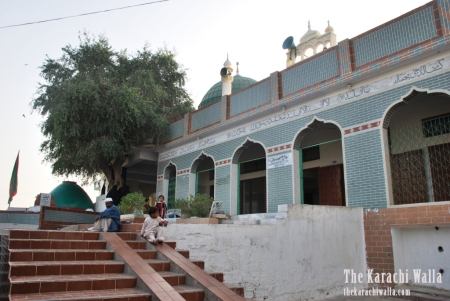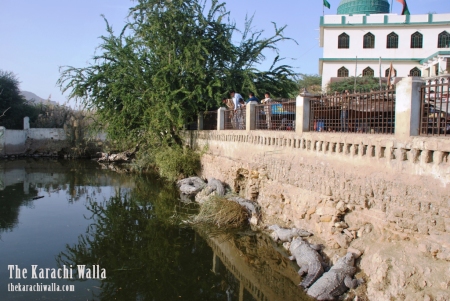
Urdu: حضرت سید محمد عظیم برخیا ، ابدالِ حق قلندر بابا اولیاء
Silsila: Azeemia
Date of Wisaal: January 27, 1979
Date of Urs: January 27
Address:
Shadman Town, North Nazimabad, Karachi, Pakistan
Shadman Town, North Nazimabad, Karachi, Pakistan
Description:
Abdal-e-Haq, Husn-e-Ukhra, Syed Muhammad Azeem Barkhiya commonly renowned as Qalander Ba Ba Auliya, (Birth: 1898 in the town of Khorja, District Buland Shehr, Uttar Pardesh, India - Wisaal: January 27, 1979, Karachi) was the founder of the Sufi Order of Azeemia. His mother was adopted by Baba Tajuddin and hence Qalandar Baba always referred him as his Nana (maternal grandfather).
During his stay in Aligarh an inclination towards spirituality developed in him and he start spending most of his time in the company of a local Sufi Kabli Baba. He used to go there early in the morning and would come back late in the evening.
After completing the 12th grade education at Aligarh, Baba Tajuddin summoned him to Nagpur, India where he spent nine years under the vigilant guidance of his Baba Tajuddin of Nagpur until he physical demise in 1929. During his stay in Nagpur, his mother died, leaving four daughters and two sons. Qalandar Baba Auliya was the eldest son and most of his siblings were very young at the time. It was becoming difficult for him to serve as the surrogate parent for his siblings. Realizing that Baba Tajuddin arranged his marriage with one of his disciples' daughter in Delhi. Qalandar Baba moved his family to Delhi and worked there as a journalist until the partition of India in 1947.
After the partition, he migrated to Pakistan along with his family, and stayed in Karachi's Lyari subdivision. At the time, Karachi was not a fully developed city and finding a job was hard. He believed in hard work and was not ashamed of odd jobs to support his family. Later on, He chose journalism as a career and was appointed the sub-editor of the Daily Urdu Dawn.
In 1956, a famous dervish of Suhurwardiya Sufi Order, Hazrat Abul-Fayz Qalandar Ali Suhurwardi, came to Karachi. Qalandar Baba Auliya met and asked to be initiated in his Order. The visiting Shaykh told him at arrive at his hotel room at three in the morning. It was during winter; nevertheless, Qalandar Baba Auliya went at 2 A.M. to the hotel where Hazrat Abul-Fayz was staying and sat at the doorsteps. At 3 A.M sharp, Shaykh Abul-Fayz opened the door of his room and summoned him inside. Qalandar Baba Auliya sat before Hazrat Abul-Fayz, and Hazrat Abul-Fayz blew three times on the forehead of Qalandar Baba Auliya. On first blow, the Alam-e-Arwah (Cosmic World) was revealed to Qalandar Baba Auliya; on the second blow, the Alam-e-Malkut (Angelic realm); on the third one, the Arsh-e-Mu'alla (The Divine Throne).
Hazrat Abul-Fayz Qalandar Ali Suhurwardi completed his teachings of Qutub-e-Irshad to Qalandar Baba Auliya, in three weeks. After that, he spiritually(oweysia) received divine knowledge from many saints including Shaikh Najamuddin Kubra.
When Qalandar Baba Auliya was working as a journalist in the local magazine in Karachi, it was his routine that he would go to the residence of his beloved disciple Khwaja Shamsuddin Azeemi where he conducted Sohbet(satsung).People from all walks of life would come to discuss various topics.
One week before of his death, he told to his disciples and friends that, "I'm a guest here for a maximum of one week". He appointed Khwaja Shamsuddin Azeemi as the head of the Sufi Order of Azeemia. He died on January 27, 1979. His tomb is in the Shadman Town subdivision of Karachi.
The essence of the teachings of Qalandar Baba Auliya is that man has not been created solely to earn a livelihood. The first and foremost purpose of his creation is that he should recognise his own Self and have an intimate relationship with his Creator.
His famous quote: 'One can not find Truth in the outward (zahir), it can only be realized by turning to inward(batin). Your inner is the doorway the Cosmos that is why Man is called microcosm (al-alam sughra).'
To spread and to be benefited with the teachings of Hazoor Qalander Baba Auliya, following three books have been inherited by Silsila-e-Azeemia:
1) Loh-o-Qalum (Pen and the Scripturum): A treasure of divine knowledge of mysteries and secrets of nature.
2) Rubaiyat-e-Qalander Baba Auliya: A valued collection of enlightening mystic verses.
3) Tazkira-e-Tajuddin Baba (R.A): An authentic work of metaphysical sciences and scientific interpretations of divinations and wonder-workings performed by spiritual people.
Additionally, Qalander Baba Auliya left countless maps and diagrams of the visible and invisible realms. He also started the publication of the monthly magazine called Roohani Digest. He also formed a Trust called The Azeemia Trust. The Trust acquired land and constructed a mausoleum over his eternal place of resting in Shadman Town, North Karachi.
Qalander Baba Auliya died on 27th January 1979 in Karachi. Every year on this date his Urs is celebrated which is attended by thousands of people from all over the country and abroad. During Urs many seminars and workshops are held. There are organized sessions of meditation under the instruction of the present Master of Silsila Azeemia; Khwaja Shamsuddin Azeemi. Qalander Baba Auliya left a widow, two sons and two daughters.
Abdal-e-Haq, Husn-e-Ukhra, Syed Muhammad Azeem Barkhiya commonly renowned as Qalander Ba Ba Auliya, (Birth: 1898 in the town of Khorja, District Buland Shehr, Uttar Pardesh, India - Wisaal: January 27, 1979, Karachi) was the founder of the Sufi Order of Azeemia. His mother was adopted by Baba Tajuddin and hence Qalandar Baba always referred him as his Nana (maternal grandfather).
During his stay in Aligarh an inclination towards spirituality developed in him and he start spending most of his time in the company of a local Sufi Kabli Baba. He used to go there early in the morning and would come back late in the evening.
After completing the 12th grade education at Aligarh, Baba Tajuddin summoned him to Nagpur, India where he spent nine years under the vigilant guidance of his Baba Tajuddin of Nagpur until he physical demise in 1929. During his stay in Nagpur, his mother died, leaving four daughters and two sons. Qalandar Baba Auliya was the eldest son and most of his siblings were very young at the time. It was becoming difficult for him to serve as the surrogate parent for his siblings. Realizing that Baba Tajuddin arranged his marriage with one of his disciples' daughter in Delhi. Qalandar Baba moved his family to Delhi and worked there as a journalist until the partition of India in 1947.
After the partition, he migrated to Pakistan along with his family, and stayed in Karachi's Lyari subdivision. At the time, Karachi was not a fully developed city and finding a job was hard. He believed in hard work and was not ashamed of odd jobs to support his family. Later on, He chose journalism as a career and was appointed the sub-editor of the Daily Urdu Dawn.
In 1956, a famous dervish of Suhurwardiya Sufi Order, Hazrat Abul-Fayz Qalandar Ali Suhurwardi, came to Karachi. Qalandar Baba Auliya met and asked to be initiated in his Order. The visiting Shaykh told him at arrive at his hotel room at three in the morning. It was during winter; nevertheless, Qalandar Baba Auliya went at 2 A.M. to the hotel where Hazrat Abul-Fayz was staying and sat at the doorsteps. At 3 A.M sharp, Shaykh Abul-Fayz opened the door of his room and summoned him inside. Qalandar Baba Auliya sat before Hazrat Abul-Fayz, and Hazrat Abul-Fayz blew three times on the forehead of Qalandar Baba Auliya. On first blow, the Alam-e-Arwah (Cosmic World) was revealed to Qalandar Baba Auliya; on the second blow, the Alam-e-Malkut (Angelic realm); on the third one, the Arsh-e-Mu'alla (The Divine Throne).
Hazrat Abul-Fayz Qalandar Ali Suhurwardi completed his teachings of Qutub-e-Irshad to Qalandar Baba Auliya, in three weeks. After that, he spiritually(oweysia) received divine knowledge from many saints including Shaikh Najamuddin Kubra.
When Qalandar Baba Auliya was working as a journalist in the local magazine in Karachi, it was his routine that he would go to the residence of his beloved disciple Khwaja Shamsuddin Azeemi where he conducted Sohbet(satsung).People from all walks of life would come to discuss various topics.
One week before of his death, he told to his disciples and friends that, "I'm a guest here for a maximum of one week". He appointed Khwaja Shamsuddin Azeemi as the head of the Sufi Order of Azeemia. He died on January 27, 1979. His tomb is in the Shadman Town subdivision of Karachi.
The essence of the teachings of Qalandar Baba Auliya is that man has not been created solely to earn a livelihood. The first and foremost purpose of his creation is that he should recognise his own Self and have an intimate relationship with his Creator.
His famous quote: 'One can not find Truth in the outward (zahir), it can only be realized by turning to inward(batin). Your inner is the doorway the Cosmos that is why Man is called microcosm (al-alam sughra).'
To spread and to be benefited with the teachings of Hazoor Qalander Baba Auliya, following three books have been inherited by Silsila-e-Azeemia:
1) Loh-o-Qalum (Pen and the Scripturum): A treasure of divine knowledge of mysteries and secrets of nature.
2) Rubaiyat-e-Qalander Baba Auliya: A valued collection of enlightening mystic verses.
3) Tazkira-e-Tajuddin Baba (R.A): An authentic work of metaphysical sciences and scientific interpretations of divinations and wonder-workings performed by spiritual people.
Additionally, Qalander Baba Auliya left countless maps and diagrams of the visible and invisible realms. He also started the publication of the monthly magazine called Roohani Digest. He also formed a Trust called The Azeemia Trust. The Trust acquired land and constructed a mausoleum over his eternal place of resting in Shadman Town, North Karachi.
Qalander Baba Auliya died on 27th January 1979 in Karachi. Every year on this date his Urs is celebrated which is attended by thousands of people from all over the country and abroad. During Urs many seminars and workshops are held. There are organized sessions of meditation under the instruction of the present Master of Silsila Azeemia; Khwaja Shamsuddin Azeemi. Qalander Baba Auliya left a widow, two sons and two daughters.


